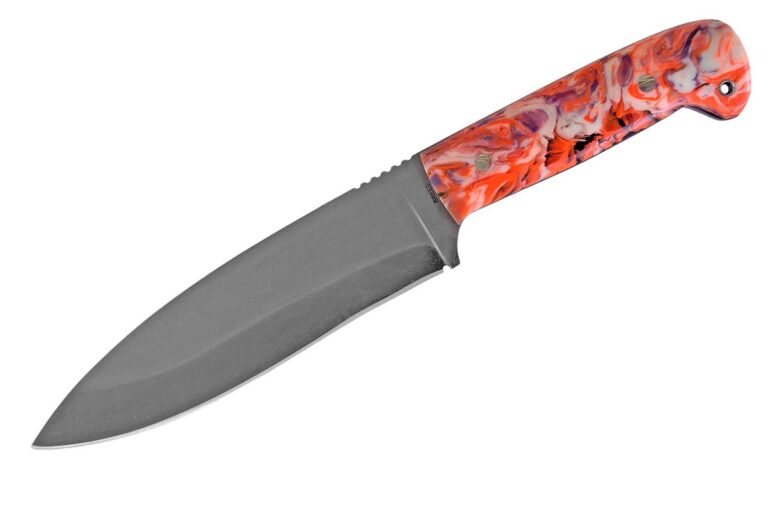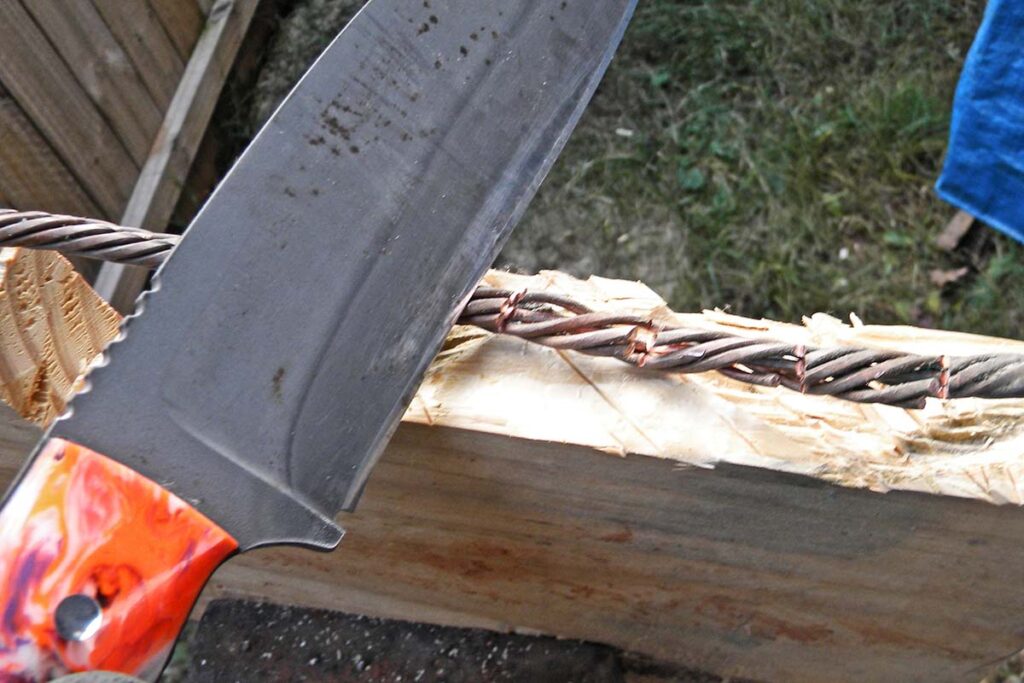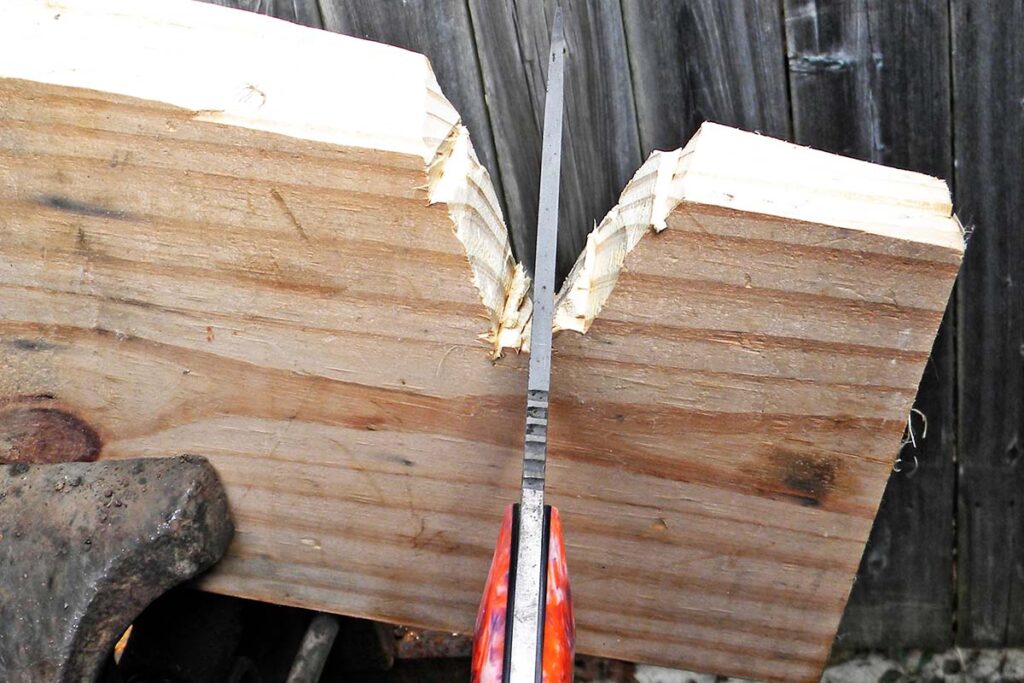
The author takes his Battle Blade to the next test level and up.
Ever since I started writing for BLADE® in 1990, I generally stick to similar cutting media to check the performance of the knives I test in “Spec Sheet.” That way it gives me a baseline as to how the different blades and their steels should perform. However, as a writer, I find it sometimes gets old doing the same testing. So why not beat the heck out of one of the test knives?
Well, first off, the knives are owned by someone else. They might be scheduled to be sold. You can see why I only push Spec Sheet test knives to a certain point. Unfortunately, the craving to give a test knife a brutal workout keeps coming, only to be done during my own testing using my knives.
Here’s a crazy idea—I’ll test one of the knives I make! So, after pleading my case to the BLADE management, it was OK’d. Now it’s time to get down and dirty with my Battle Blade that has been my truck knife for the past year.
Let the whacking begin.
Battle Blade Vs Normal Media
Serious whacking aside, I still executed a 20-pound-bond paper slice to show initial edge sharpness. The Battle Blade zipped quickly through the paper even with rust spots on the blade and edge. It was very smooth and aggressive during slicing.

On to a nice 2×8 pine board locked in my shop leg vise. After 20 whacks I had a deep “V” chopped into the wood. The exercise didn’t bother the edge at all; it took a three-quarter-to-1 inch bite on each chop. The handle was comfortable but slightly smooth. (I should have put a thong cord on it.)
Since the whitetail antler I normally use in stories for edge whacking was all whacked up, it was time to replace it. As a result, I chopped it up into 1-inch pieces. The Battle Blade removed all the tines with nice, clean chops. The edge was still very sharp with no damage. Now I have chunks of deer antler all around my forge!
Battle Blade Vs Abnormal Media
For the first “abnormal medium” I went with 3/8-inch-diameter twisted copper wire. I used the Battle Blade as a draw knife to flatten the 2×8 for a surface on which to chop the copper braid. Six hard whacks and the edge still didn’t make it through all eight wires. It seems the Battle Blade drove the last two wires into the 2×8. Note to self: use a hardwood next time. The copper braid only put a few streaks on the blade. There was no damage to the edge.

Next up: the acetone can stab. The Battle Blade fully penetrated both sides of the can repeatedly. I was worried about stabbing the leg vise more than any damage to the blade from the can. There were some nice scratches on the finish but the edge held up perfectly, as well as the tip.
It was time to get some steel involved: an older patio chair headed to the scrapyard, and its steel tubing. Bingo! So I dragged the chair into my forging area and prepared to trash my Battle Blade. Swinging as hard as I could, I chopped down into the arm of the chair. A loud clang let me know it was a solid hit. The Battle Blade bit a half-inch deep, through the top and bottom corners of the chair, along with the sidewall. I saw a little glint from the blade’s edge. Oh well! I gave the chair arm seven more very hard whacks. The edge had two little glints of rolls and three very small nicks.

The edge still felt sharp, so I returned to the 20-pound-bond paper slice. The edge sliced the paper, though not as smooth as at the start. I’ll take that anytime.
Final Cut
I’m very happy with the performance and feel of the Battle Blade. Normally I use a better gripping handle material for this model but this one’s mine. It had to be bold. The only change I’ll make, thread some cord through the thong hole for a more secure grip.
Battle Blade Specs
Maker: Breed Custom Knives
Blade length: 75/8”
Blade material: 80CrV2 carbon steel
Blade grind: Full flat
Blade @ thickest: 3/16”
Blade finish: Bead blasted
Heat treatment: Differential
Handle material: Swirl by J. Hue Customs
Weight: 15 ozs.
Overall length: 13 1/8”
Sheath: Kydex w/Ulticlip
Weight w/sheath: 1.25 lbs.
Maker’s price for a similar knife & sheath: $450
Read More Knife Reviews:
- Oknife Beagle Review
- Versa Rescue Knife Review
- Knife Review: CRKT Bamboozled
- M-1 Folder Review: How Good Is This Folder?
 NEXT STEP: Download Your Free KNIFE GUIDE Issue of BLADE Magazine
NEXT STEP: Download Your Free KNIFE GUIDE Issue of BLADE Magazine
BLADE’s annual Knife Guide Issue features the newest knives and sharpeners, plus knife and axe reviews, knife sheaths, kit knives and a Knife Industry Directory.Get your FREE digital PDF instant download of the annual Knife Guide. No, really! We will email it to you right now when you subscribe to the BLADE email newsletter.






